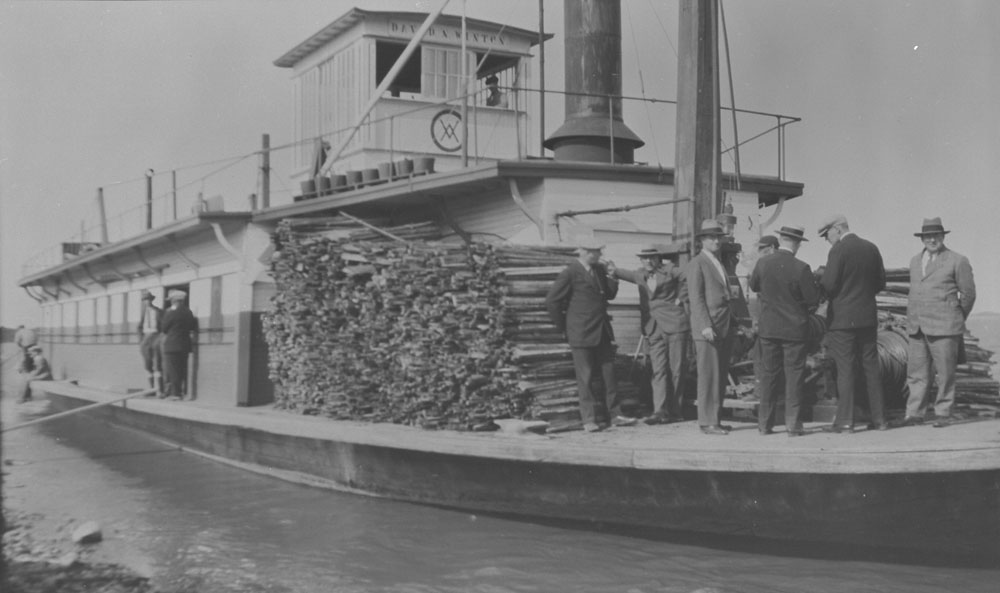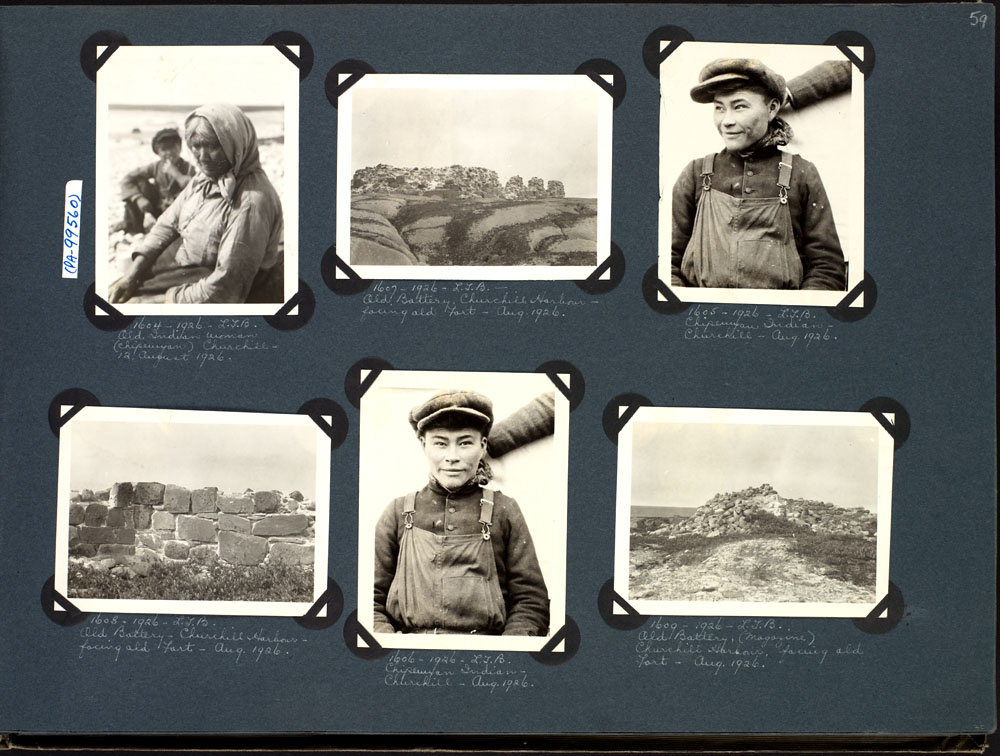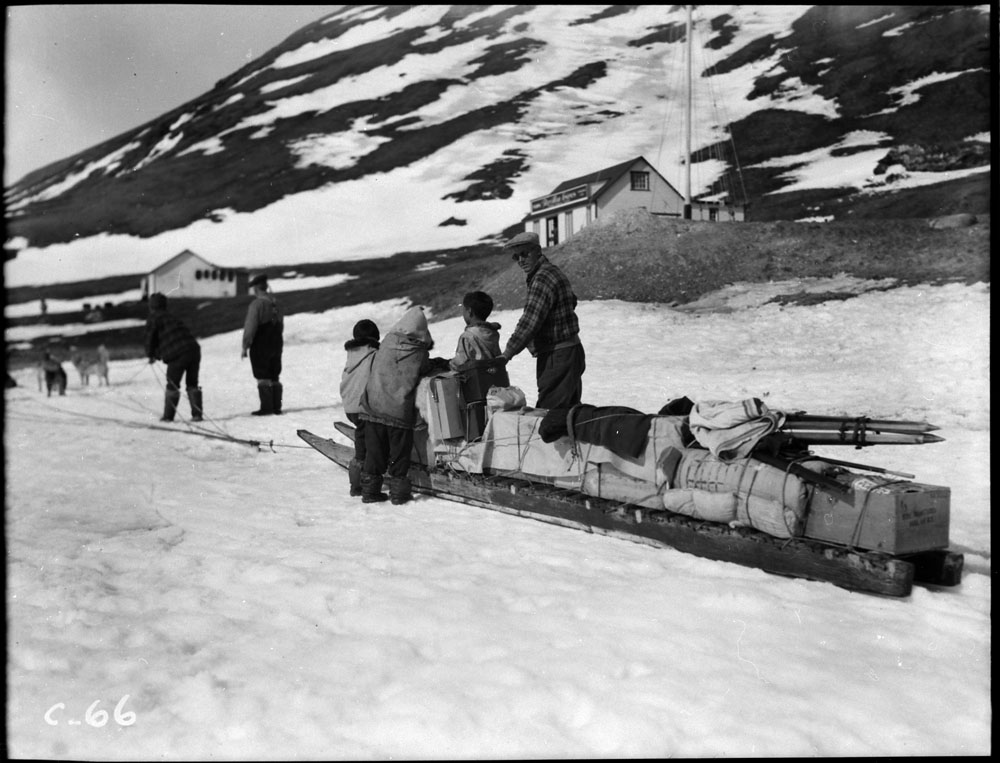Chapter 2. Confederation in Conflict
2.10 The North
At the heart of imperial expansion is the need to redraw maps, to impose new patterns of communication, and to reconfigure economic orders to fit the new paradigm. Canada — through more than two centuries of French and then British colonial effort — was not a truly northern entity. It was an inland colony that extended down the throat of the St. Lawrence River and into the gut of the continent along the Great Lakes. It related to the rest of North America through river systems that flowed into the Great Lakes and the Laurentian system. It extended no further north, in political terms, than the Canadian Shield and the height of land. Leaping over that barrier into the Rupert’s Land watershed was a significant task, part of which it accomplished through the North West Company’s trade network in the West before 1821. However, from 1821 (and including the merger of the NWC with the London-based HBC), Canadian influence in the West was modest. The annexing of Rupert’s Land in 1869-70 flagged a movement beyond the old colonial boundaries, but these efforts primarily concentrated on Manitoba and what would become the Prairie provinces. The expansion into the North held out less drama but it was no less portentous.
The North in the Late 19th Century
At the time of Confederation, the North probably contained significantly fewer human beings than it had two (or even just one) hundred years earlier. The boreal forest regions held large populations of larger mammals — deer, moose, and woodland caribou, for example — on which a human population could survive, but the fur trade with Europeans and Canadians reduced mammal numbers to very low levels in the parkland or prairie regions. Fishing remained a reliable economic activity for subsistence communities, but the wherewithal for trade with Euro-Canadian companies was not as great as it once was.
Much of the northern human population west of Hudson Bay fell into two linguistic/cultural groups. Across the middle of the region and into the north and far west (the Yukon), Athapaskan-speakers dominated. The Dunne-za (aka: Beaver), Chipewyan, and Dene (aka: Slavey) held much of the southern part of this zone, while the Tłı̨chǫ (aka: Tlicho, Dogrib) dominated in the north and west of the Mackenzie River. To the east and hugging the North Saskatchewan River were the Cree, along with the relative newcomers, the Métis. European numbers were small, made up of traders, missionaries, and a handful of others.[1]
To the south and east of Hudson Bay (still very much to the north of Old Canada) were Cree and Innu (aka: Montagnais) communities which had experienced extensive contact with the French and later the British through the fur trades emanating from Montreal and Quebec on the one hand, and HBC forts like Moose Factory on the other.
Still further north, along the Arctic and around both lips of the mouth of Hudson Bay were large Inuit populations. Limited contact with Europeans, down to the late 19th century, had insulated the Inuit from some of the worst effects of exotic diseases. And while metal imports had found their way into the Inuit toolbox, life as a whole had not (as yet) been overhauled.
Infrastructural Change
The story of the Prairie people’s armed resistance in 1885 invariably points to the significance of the CPR in delivering the telling blow of Canadian military power. What is often overlooked is the role played by steamboats on the Saskatchewan River. Although northern rivers iced up annually, they were the principal highways of the region in the spring and summer months and beyond. The potential of steamboat and paddlewheeler technology on these corridors was never fully tested. The rapid expansion of rail systems saw to that. River shipping nevertheless marks an important transition from the old York Express corridor of river and lake transportation, which oriented northern trade across the middle of what is now Western Canada to Hudson Bay and then to Europe, to one that was more southern-looking.

Perhaps this transition is most evident in Manitoba. In the years before Confederation, the Red River settlement was the metropolis of a trading network that extended from what is now North Dakota to York Factory on Hudson Bay. The chains of rivers and lakes oriented trade from the warmer semi-agricultural highlands of the Selkirk settlement to the entrepôt — and gateway to Europe — in the north. After 1912 and north of the 49th parallel, all of this was contained within the provincial boundaries of Manitoba. The arrival of Canada in 1870 meant that Winnipeg would shift its view from the north to the southeast. Instead of prairie wheat finding an outlet in the Arctic, it was pulled to Canada. Instead of Churchill emerging as a major centre of transshipment, Thunder Bay (aka: Port Arthur and Fort William) did so instead.[2]
A similar pattern had emerged, before 1900, in what was then the District of Athabaska (called Northern Alberta since 1905). In the 1880s, steam-powered shipping was introduced to Athabasca River and Lake with the effect of shifting trade and population into that corridor. Stretching as far north as Great Slave Lake and the Mackenzie River, this network ensured the emergence of Edmonton as the key economic node in the northwestern prairies. This region, too, was being incorporated into an economic system based in the Laurentian heartland of Canada.
Cultural Changes
The events of 1885 resulted in a substantial re-migration of Métis into the northern-Northwest. Progressively displaced — in many instances systematically so — by the incoming Canadian populations, the Métis found their economic niche was beginning to disappear. The bison hunt was at an end, provisioning forts was no longer a sustainable business for more than a few, and the freighting industry that had made such good use of the Red River cart and the Métis’ ox teams was evaporating. The new steam-age transportation technology first cut them out of the southern plains and then, with extensions to the northern plains by branch lines even before 1900, the Métis were driven north of Edmonton and Saskatoon into the boreal forests. This movement, of course, had consequences for the Athapaskan-speakers of the central-north, whose resource base was now doubly strained. At Fort Chipewyan, for example, the Métis and the Chipewyan generally did not mix (nor did the French-speaking and Catholic Métis have much to do with the English-speaking and Anglican merchant class which was, to make matters more complex, a socio-economic barrier as well).[3] Elsewhere in the Northwest there were many instances where the Métis married and/or assimilated into Aboriginal societies and re-configured their self-identity as Dene or Dunne-za.
The presence of missionaries from the mid-19th century across much of the sub-Arctic suggests cultural change was underway. Certainly cultural or at least spiritual assimilation was the missionaries’ goal in these years, not service to communities or some kind of administrative interface. If they were educators, they were educators within a Euro-Canadian Christian tradition. In this respect, at least, the role of missionaries had not changed much since the days of the Jesuits in Wendake (aka: Huronia) in the 17th century. Scholars like Kerry Abel have questioned the extent to which the missionary message in the North was persuasive. Certainly there were different levels of exposure to the Christian doctrine, and Aboriginal bands that gathered in trading post communities were more at risk of proselytization than the more remote and nomadic peoples. And there was, to be sure, initial curiosity and even enthusiasm for the missionary message. By 1900, however, that early interest had diminished and Christianity was either peripheral or hybridized into a syncretic belief system among Aboriginal converts.
As the representatives of Euro-Canadian society in these communities, the missionaries had a special role to play. They monitored social and economic change and reported to Central Canada as conditions shifted. It has been suggested that there is a fairly consistent trend in Canadian history that sees the arrival of traders followed by missionaries, and then military or police power of some kind: commerce, Christ, and cops. This pattern is certainly evident across the North as the missionaries increasingly called upon the state to provide NWMP/RCMP backup from the 1890s-1930s.

Economic and Demographic Change
The fur trade, however, sustained and built an economic bond between the Inuit and Euro-Canadians. As was the case in other fur trade frontiers in North America, pressure to hunt commercial species meant that Inuit attention was drawn away from subsistence hunting. Dependency grew as a result. When demand for luxury products like furs collapsed in the 1930s, many of the Inuit fur-hunting communities were pitched into poverty and hardship.
The 1920s had witnessed a boom in the fur-trade tied to the brief flicker of an international luxury market aimed at the growing middle class in Europe and the Americas. This was good news for Native trappers and traders who were being paid much higher prices for more kinds of animals than was the case even 20 years before. In part this was driven by the arrival in 1901 of the Parisian Revillon Frères fur trading company. Prices went up as Revillon went toe-to-toe with the local HBC traders. This situation, of course, invited growing competition from non-Native trappers and hunters, some of them long-residents in the region by now. The Innu of Labrador, for example, found themselves pushed further and further inland in the 1920s, trying to eke out an existence now based almost entirely on the trade in furs. The possibility of fishing and hunting for food was, by this point, so reduced that they had no option but to adopt a European diet and factory-produced Euro-Canadian clothing made available through the trade in furs.[4]

European, Canadian, and American intrusions into the North increased as the 19th century was drawing to a close. American whaling fleets began working the Beaufort Sea in the western Arctic and British whalers intensified their efforts in the eastern Arctic. Inuit people found economic opportunities with the fleets but they also found alcohol, sexually transmitted diseases, smallpox, and other exotic illnesses. The Beaufort ports were, according to one source, the scene of “unprecedented debauchery” and the Sadlermuit of Southampton Island were wiped out by smallpox.[5] The difficulty of disease transmission across great distances between relatively small numbers of hosts no doubt limited the impact of any one epidemic like smallpox or measles; the increase in foreign shipping along the coastline mitigated the advantages of isolation. The original Inuvialuit people of the Yukon shore of the Beaufort Sea were effectively extinct by 1920. Even the arrival of the RCMP in 1895 could do little to stabilize, let alone reverse this trend. Changes in women’s fashions (which effectively put an end to the whale-bone corset) and the shift from whale oil to mineral oil did, however, cool the heat of change in some parts of the Arctic.[6]
The front on which the colonization of the indigenous economy was being fought in the Yukon shifted south in 1896. At that time gold was discovered at Bonanza Creek. Canadian responses included an increased RCMP presence, but tactics devised to prevent lawlessness were ill-suited to the protection of Aboriginal interests. As was the case in the Cariboo 40 years earlier, Aboriginal fishing sites were seized and river ecosystems compromised by foreign miners. The RCMP did address Aboriginal concerns regarding the newcomers’ use of poison on traplines, but they also elected to enforce the regulation of hunting among First Nations.
Being part of Canada meant many things in this context. It meant a shift from localized subsistence economies, which depended on a mobile population able to strike out in a timely way to pursue migratory herds, spawning fish, briefly available plants, and opportunities to trade with neighbours. In its place a new infrastructure of commerce and human intercourse arrived via steam-powered vessels. Its personnel included representatives of alien belief-systems (some of which were locked in competition), law enforcement officers whose laws were themselves exotic and seemingly arbitrary, and a commercial/administrative environment which increasingly encouraged permanent settlement in fixed communities. Ottawa formally took on responsibility for northern populations in 1924 when the Indian Act was amended to include the Inuit. The Inuit, however, were not viewed as “Indians” and so fell between the administrative cracks.[7]
The Race to the Pole
The first three decades after Confederation were marked by an international fascination with the polar region. Scientific missions were the order of the day, although Canada did not engage in this particular stampede. The race to the North Pole was one aspect of this enterprise, one that set international teams against one another in highly publicized and popularized adventures. Charting the Northwest Passage was another feature of this phenomenon. All of this activity increased traffic in the region and increased the likelihood of Inuit exposure to disease vectors. In also facilitated the movement of Inuit people themselves, with Greenland Inuit reputedly appearing on both Ellesmere and Baffin Islands.[8]
To substantiate Canadian claims to sovereignty in the region and to counter foreign incursions, Ottawa established several missions whose task it was to make an official claim on the northern islands and seas. American and European opposition to these claims obliged still further investment in expeditions and regular patrols. Every one of these efforts brought Canada more regularly into contact with the Indigenous peoples of the region. At the same time, Canada viewed the Inuit with a curious ambivalence. The Inuit were international — they were to be found in American and Danish territories as well as Canadian — and there were few opportunities to integrate them into the growing southern economy before the mid-20th century.
Key Points
- At the time of Confederation the North was of limited interest to Canada.
- The region’s population was diverse but vulnerable. Disease and economic dislocation were the main and ongoing threats.
- The arrival of steam-powered shipping throughout the region increased integration into the continental and global economy, while exposing populations to new disease vectors.
- Population movements accelerated, as did missionary efforts to effect cultural change.
- The most dramatic short-term impact on the region arrived with the Yukon gold rush and the Beaufort Sea whaling industry. Increased activity in the fur trade in the 1920s also had significant consequences.
- Canadian territorial and sovereignty issues increased in the early 20th century, resulting in a greater state presence.
Long Descriptions
Figure 2.19 long description: Six photos from August 1926. From left to right, top to bottom:
- An old Chipewyan woman. Captioned “1604-1926-L.L.B. Old Indian woman (Chipewyan). Churchill—12 August 1926”
- A low wall used for fortification during battle. Captioned “1607-1926-L.L.B. — Old Battery. Churchill Harbour—facing old Fort—Aug. 1926”
- Young Chipewyan man wearing overalls, a long-sleeved shirt, and a newsy cap, looking away from the camera and smiling. Captioned “1605-1926-L.L.B. Chipewyan Indian—Churchill—Aug. 1926”
- A low wall used for fortification during battle. Captioned “1608-1926-L.L.B. Old Battery—Churchill Harbour—facing old Fort—Aug. 1926”
- Young Chipewyan man wearing overalls, a long-sleeved shirt, and a newsy cap, looking at the camera and smiling. Captioned “1606-1926-L.L.B. Chipewyan Indian—Churchill—Aug. 1926”
- Low wall used for fortification sitting on a hill. Captioned “1609-1926-L.L.B. Old Battery, (Magazine) Churchill Harbour, facing old Fort—Aug. 1926”
Media Attributions
- Steamer Trip on Saskatchewan River © A. Buisson, Canada Dept. of Mines and Technical Surveys / Library and Archives Canada (PA-014005) is licensed under a Public Domain license
- Collage, August 1926 © Department of Indian and Northern Affairs Canada / Library and Archives Canada (MIKAN no. 4848722) is licensed under a Public Domain license
- Komatik with supplies at Revillon Fréres post © Library and Archives Canada (PA-055573) is licensed under a Public Domain license
- Donald Wetherell and Irene R.A. Kmet, Alberta’s North: A History, 1890-1950 (Edmonton: University of Alberta Press, 2000), 4-5. ↵
- In the 1870s and ‘80s there was a ferocious political and physical battle between Manitobans and Ontarians regarding the boundary between the two provinces. The epicentre of the dispute was the town of Rat Portage (aka: Kenora), where both provinces established a jail and a courthouse and sent in their own officials (who then fell to fighting one another). What was at stake was the gold and other mineral reserves of the region. Needless to say, Manitoba lost this battle and thus any hope of direct access to the Great Lakes. ↵
- Ibid., 6-7. ↵
- Lynne D. Fitzhugh, The Labradorians: Voices from the Land of Cain (St. John’s: Breakwater, 1999), 375. ↵
- Donald Purich, The Inuit and Their Land: The Story of Nunavut (Toronto: James Lorimer & Company, 1992), 30. ↵
- Olive Dickason, Canada’s First Nations: A History of Founding Peoples from Earliest Times, 3rd edition (Don Mills: Oxford University Press, 2002), 361-2. ↵
- Ibid., 36-7. ↵
- Ibid., 32. ↵

